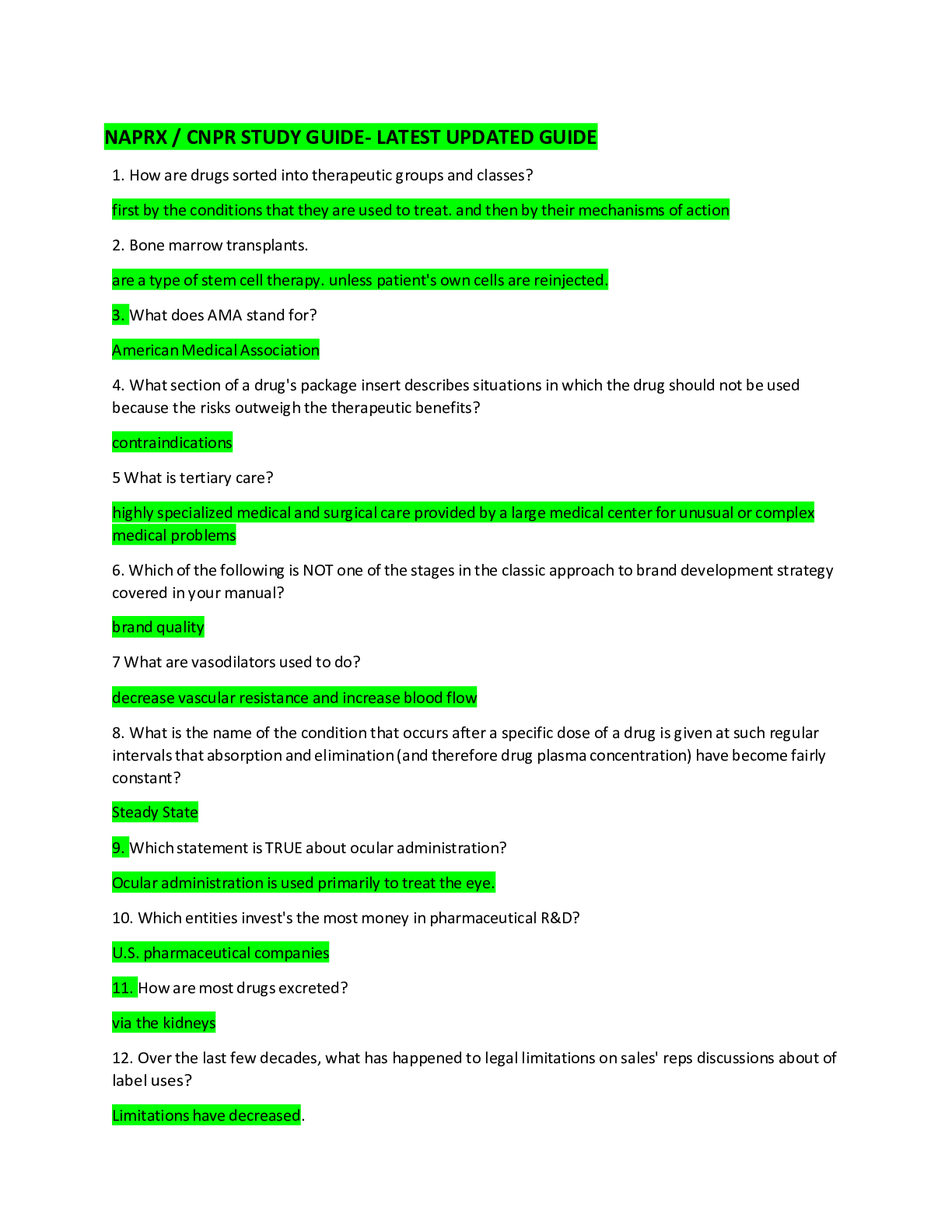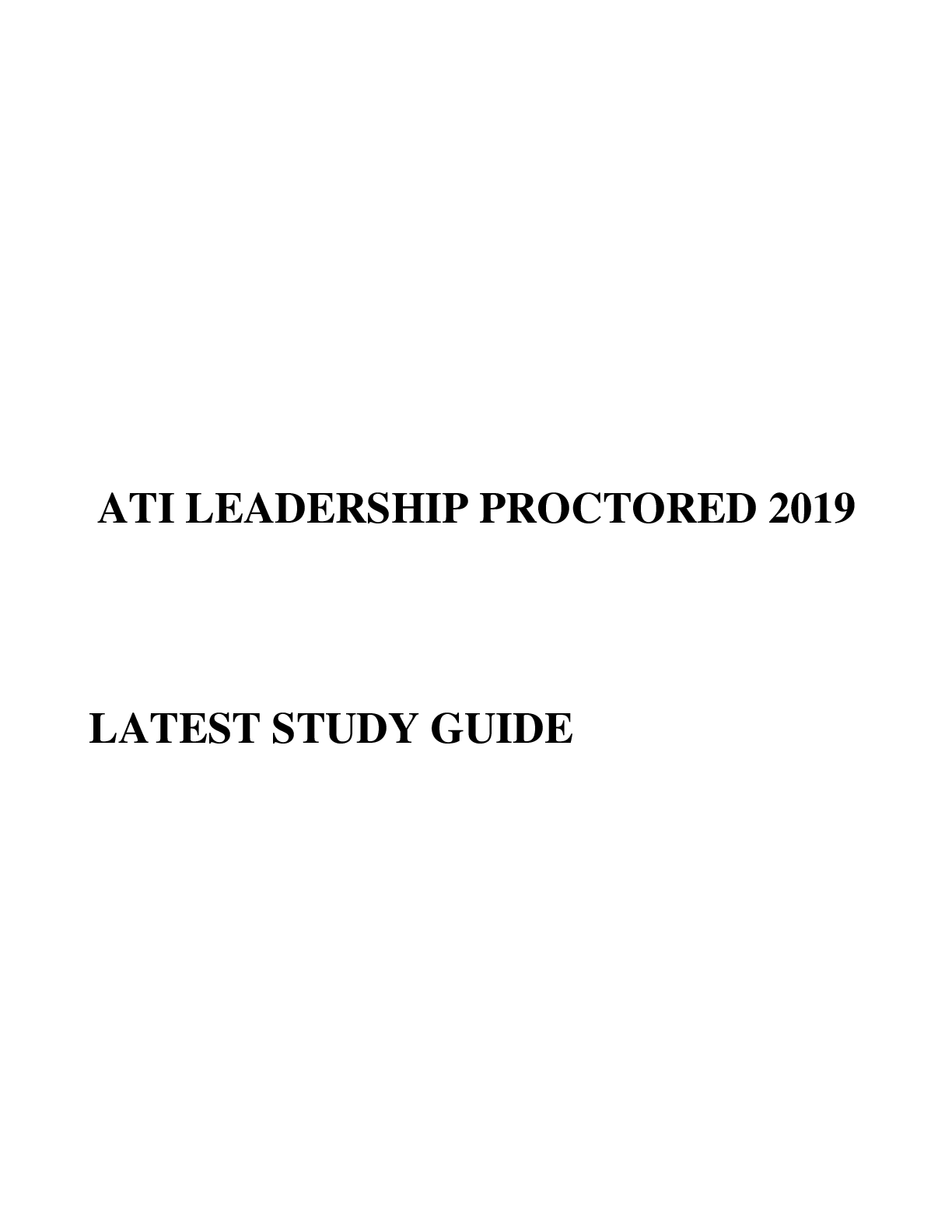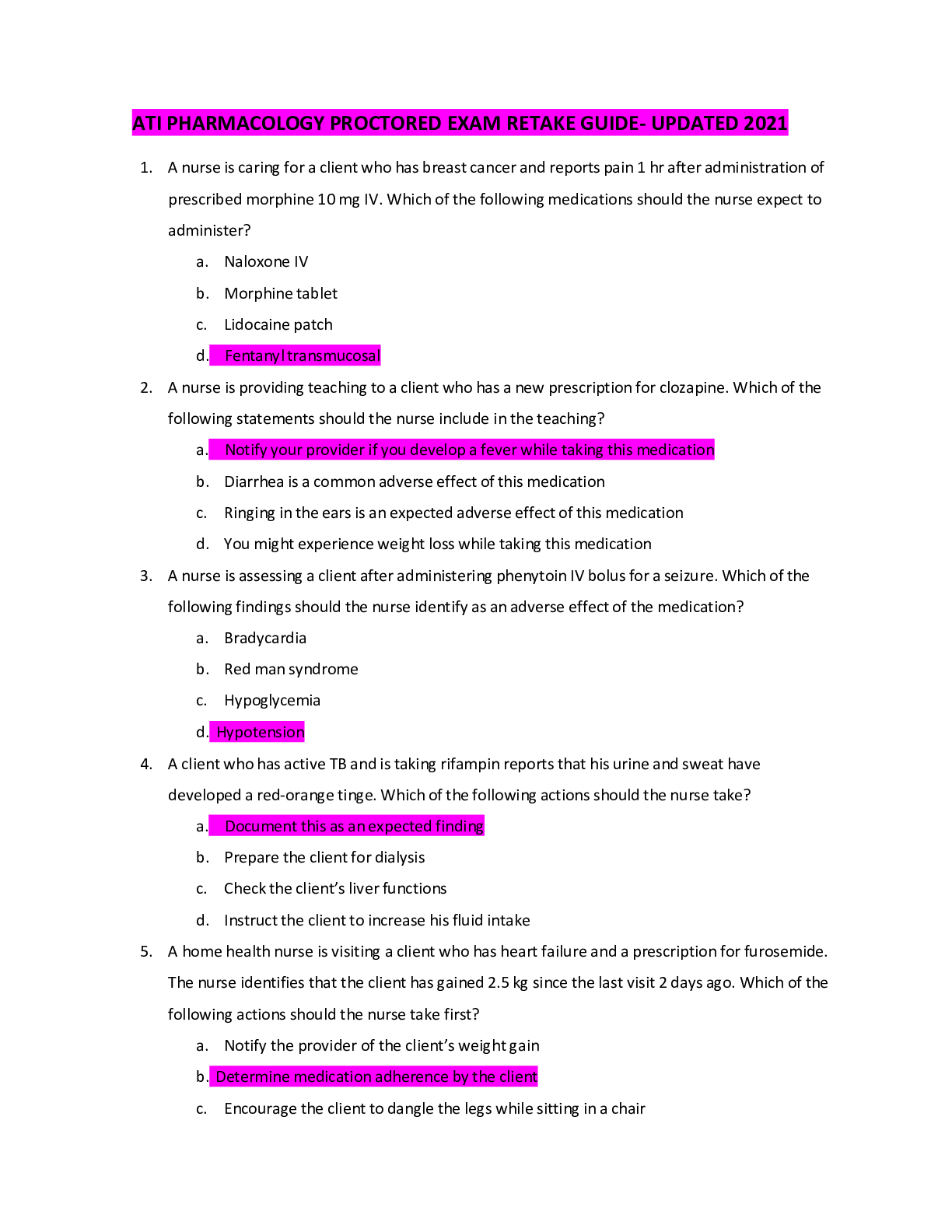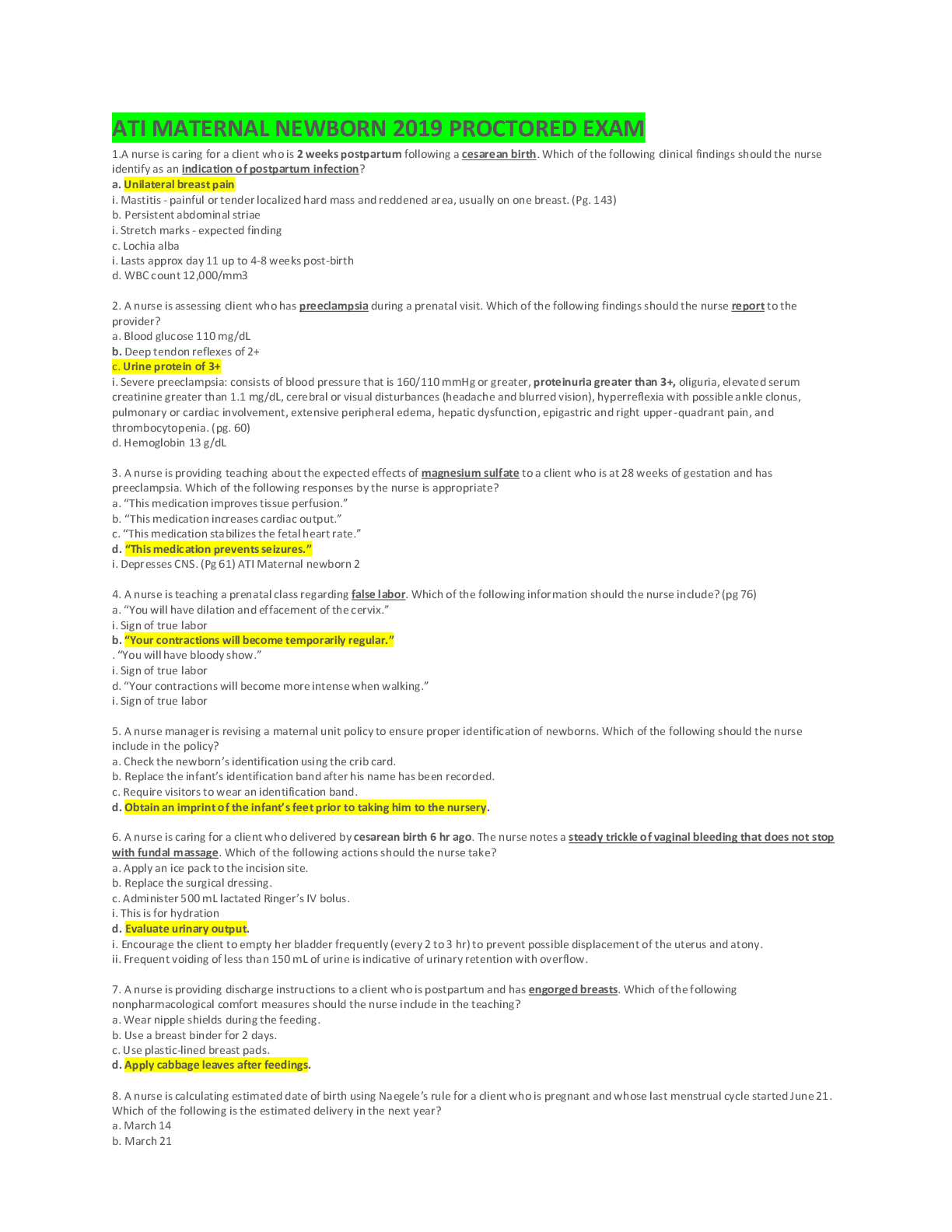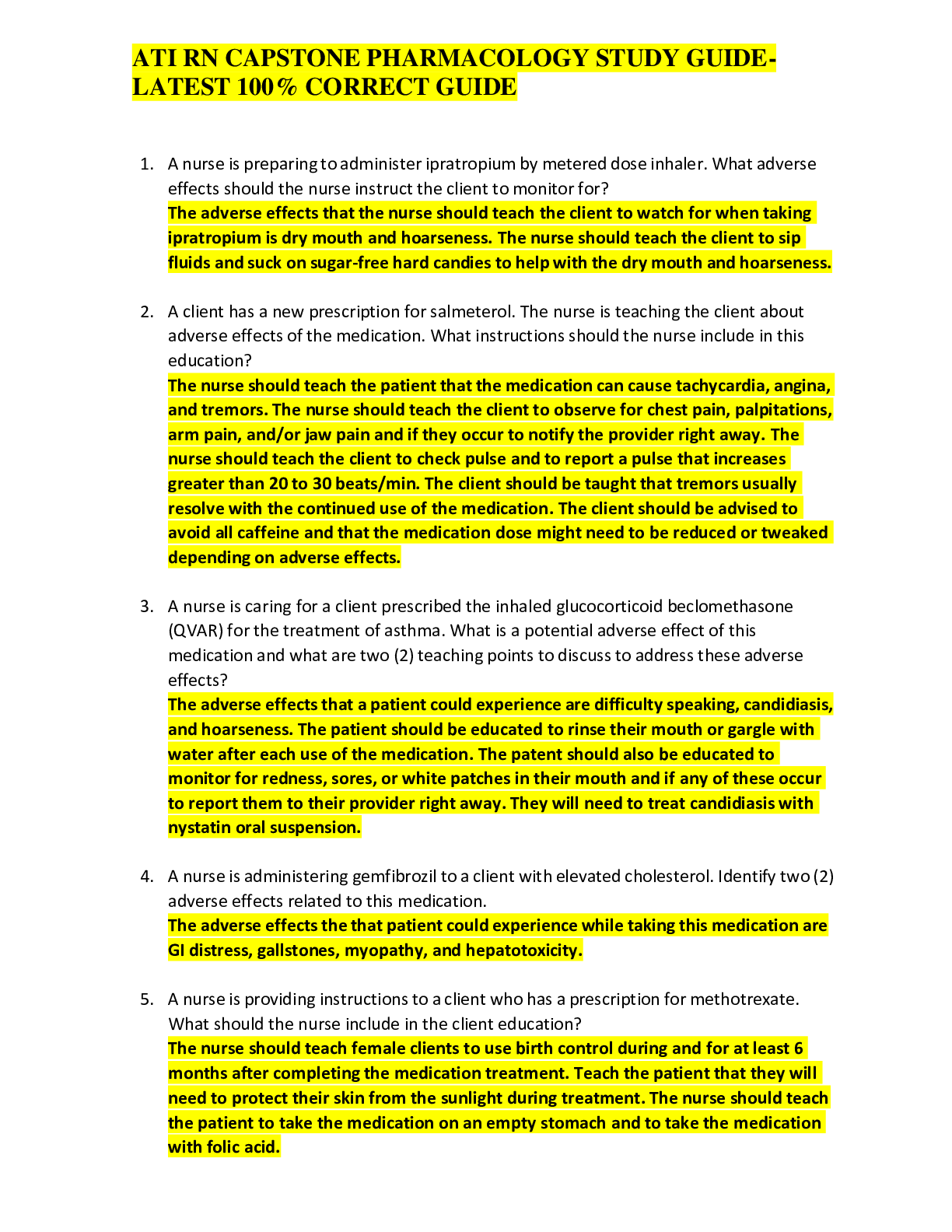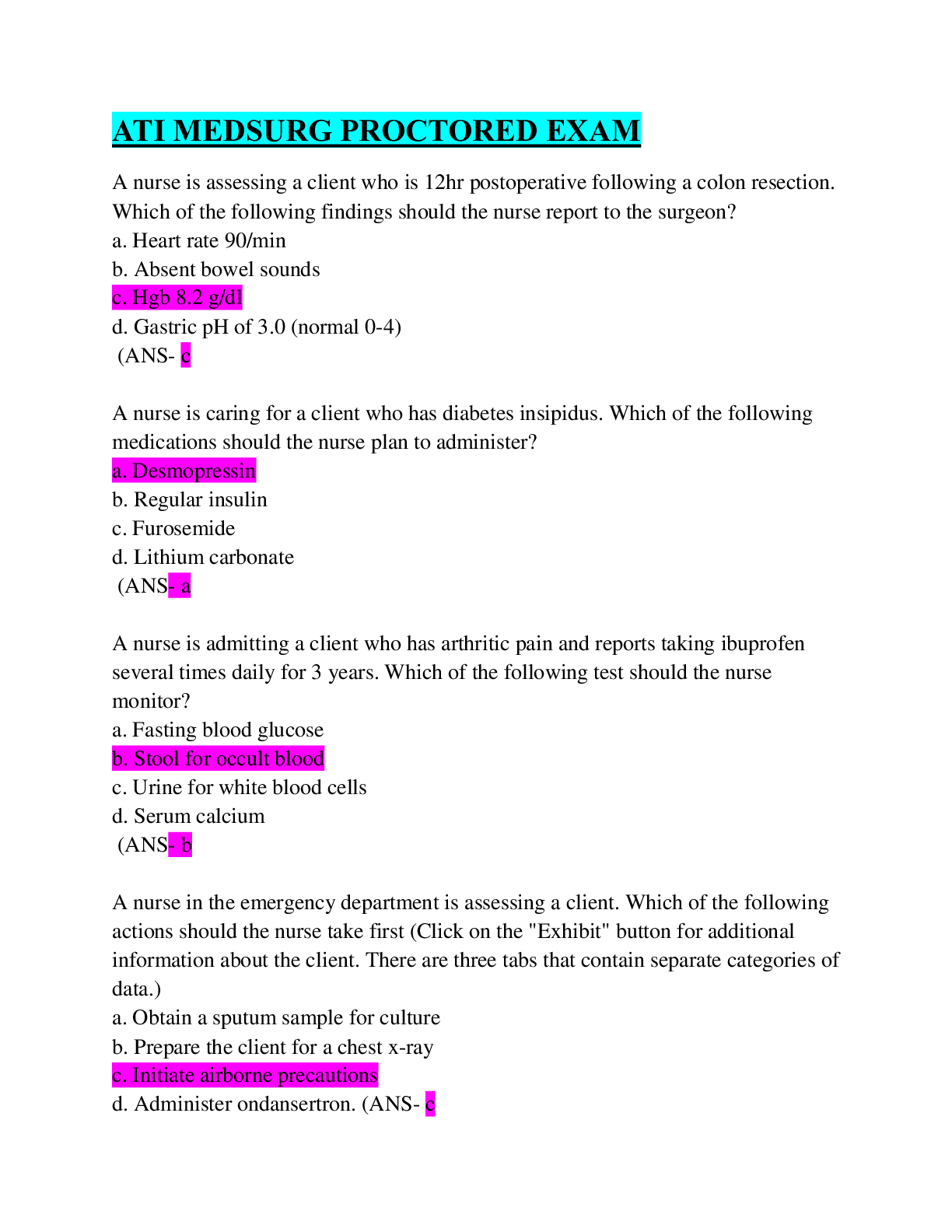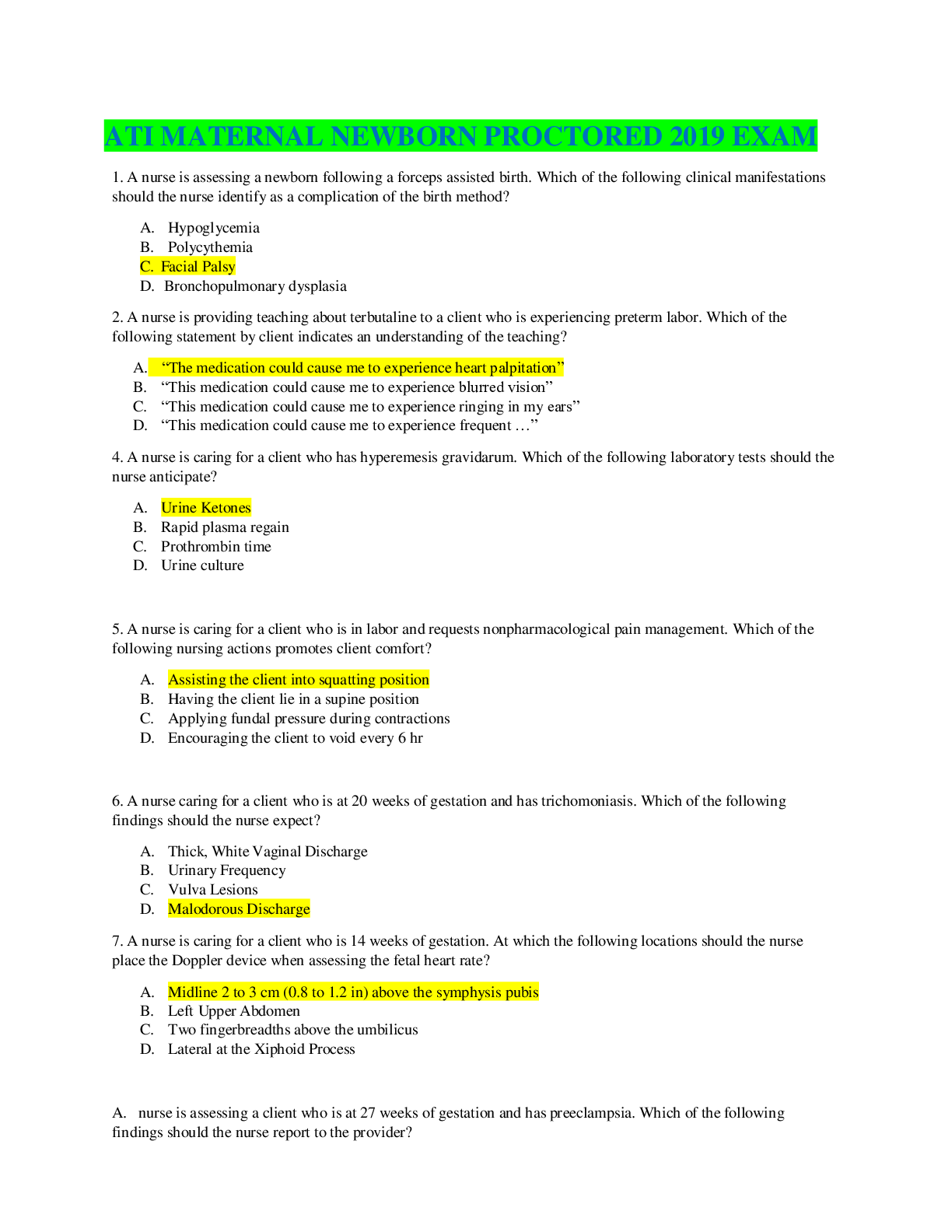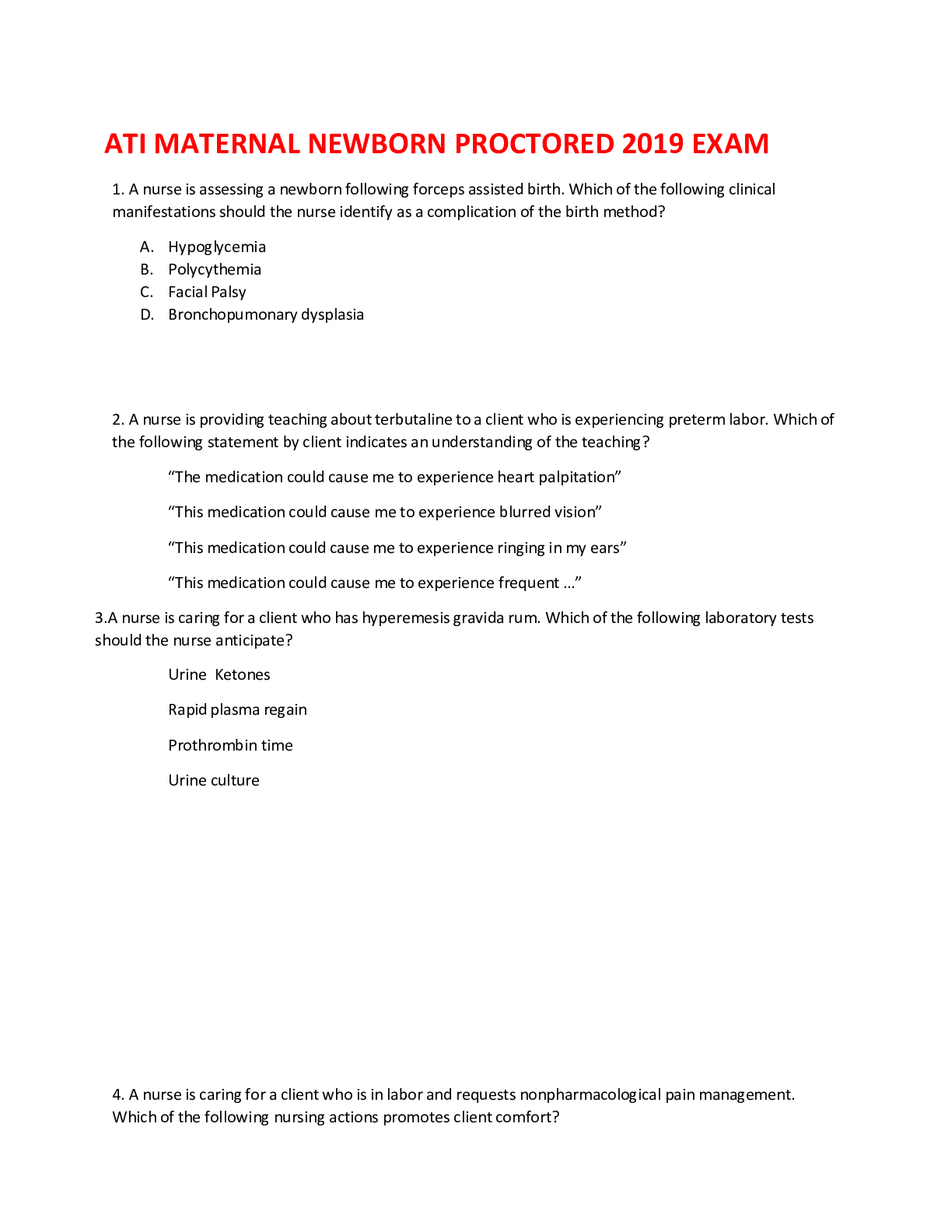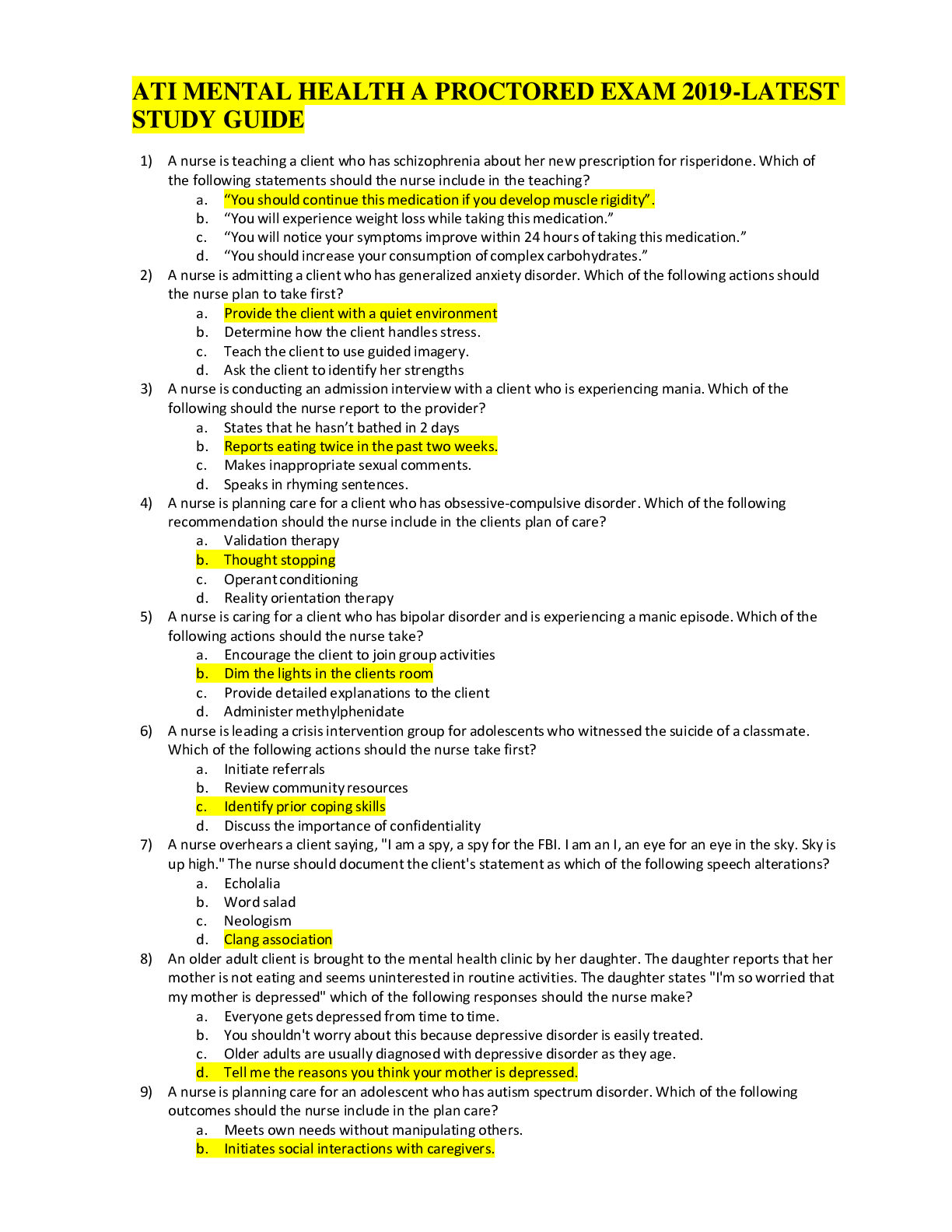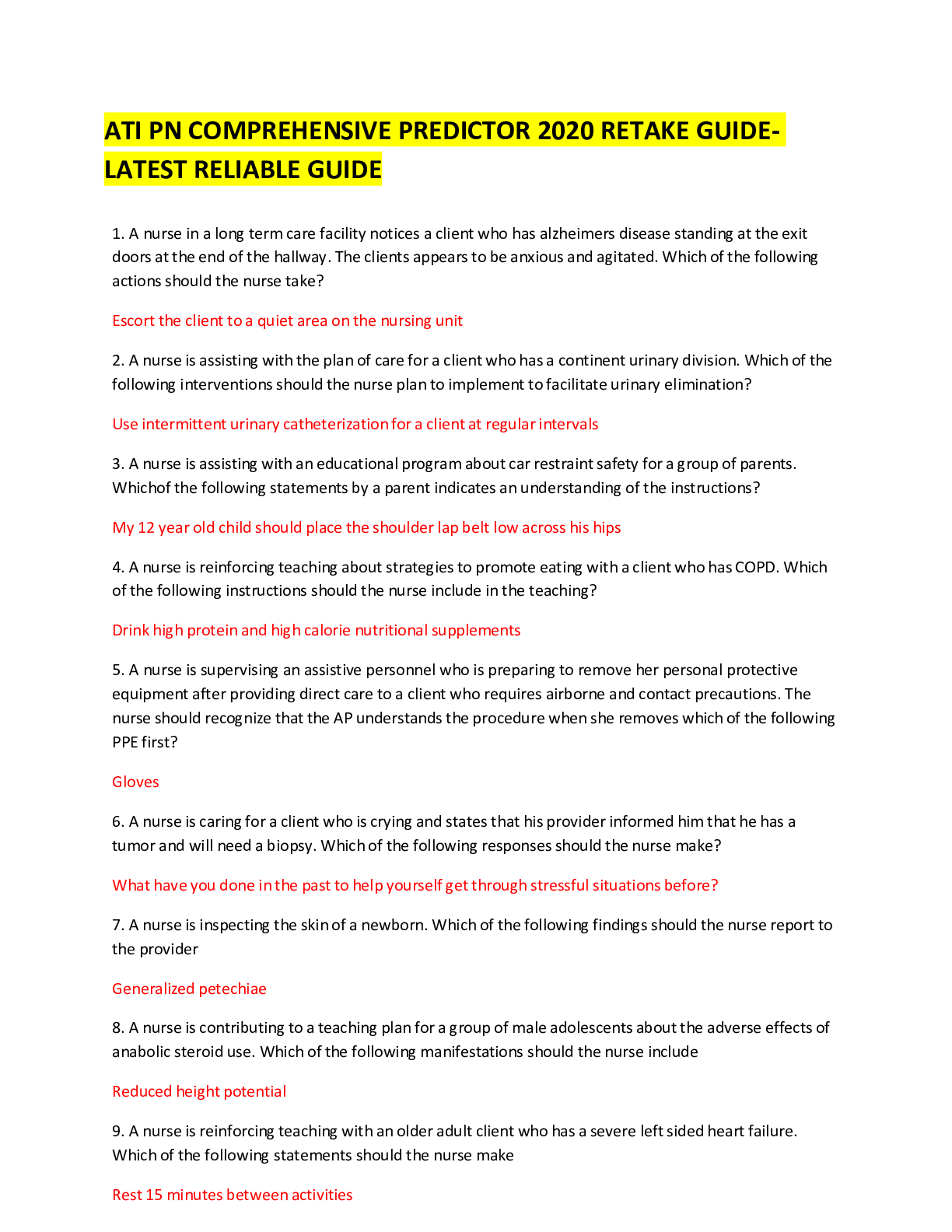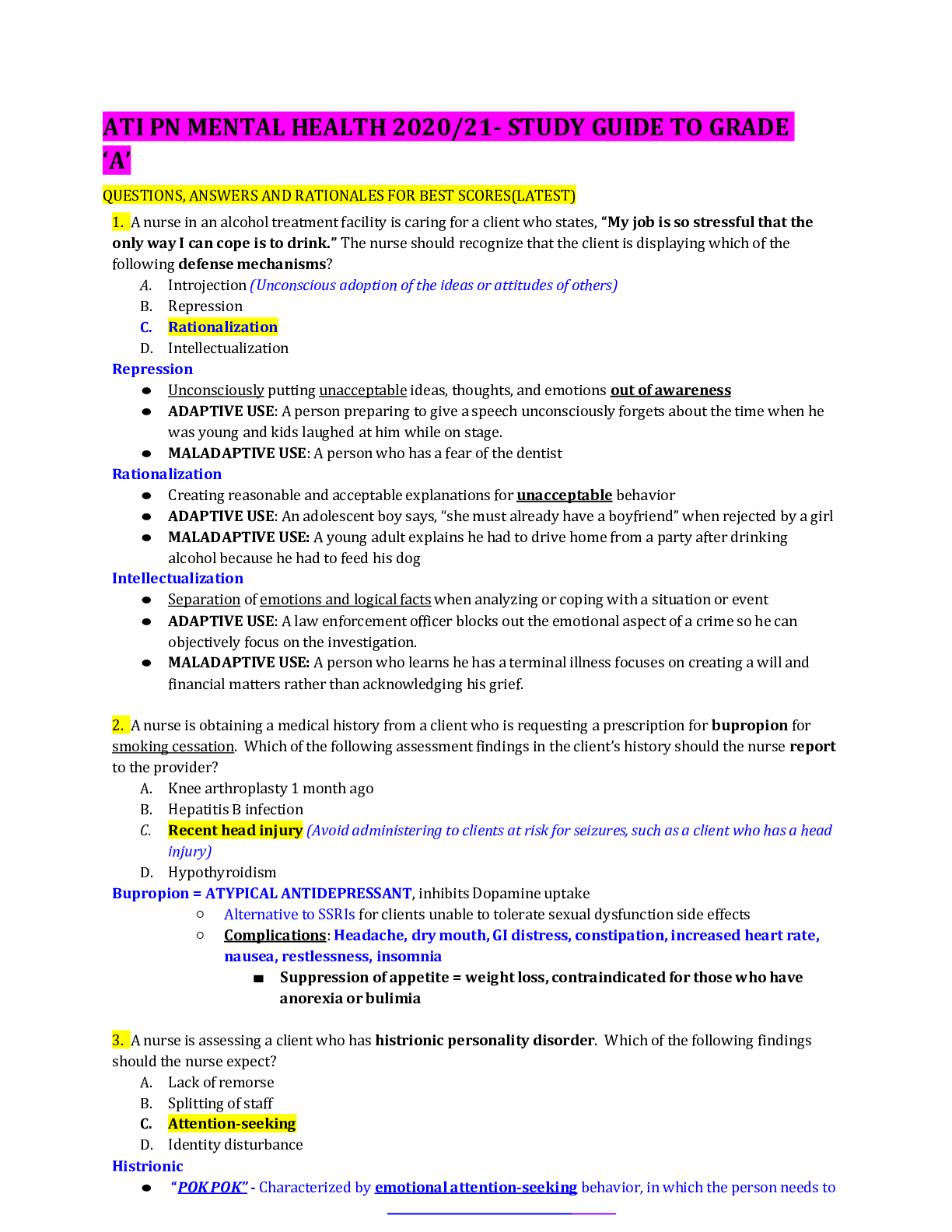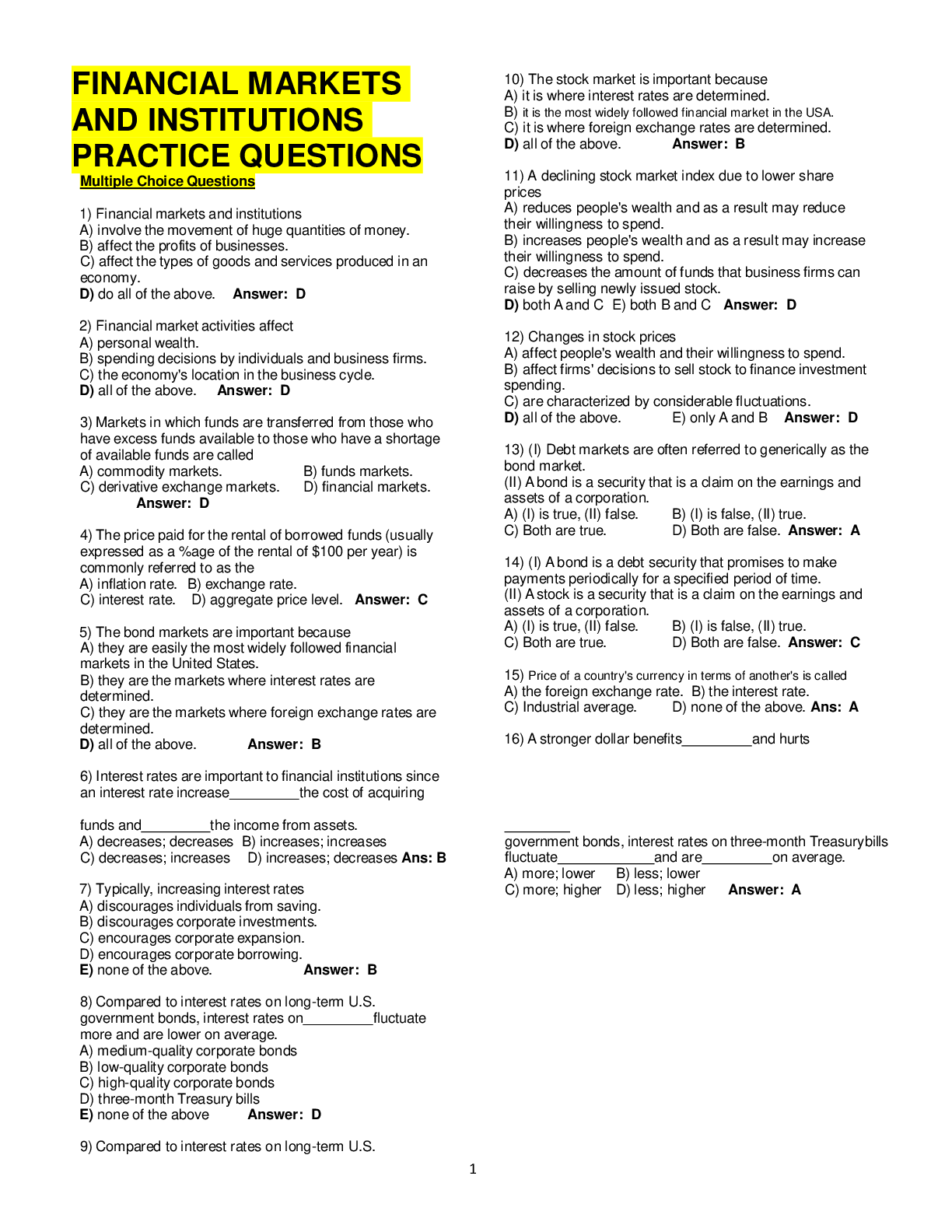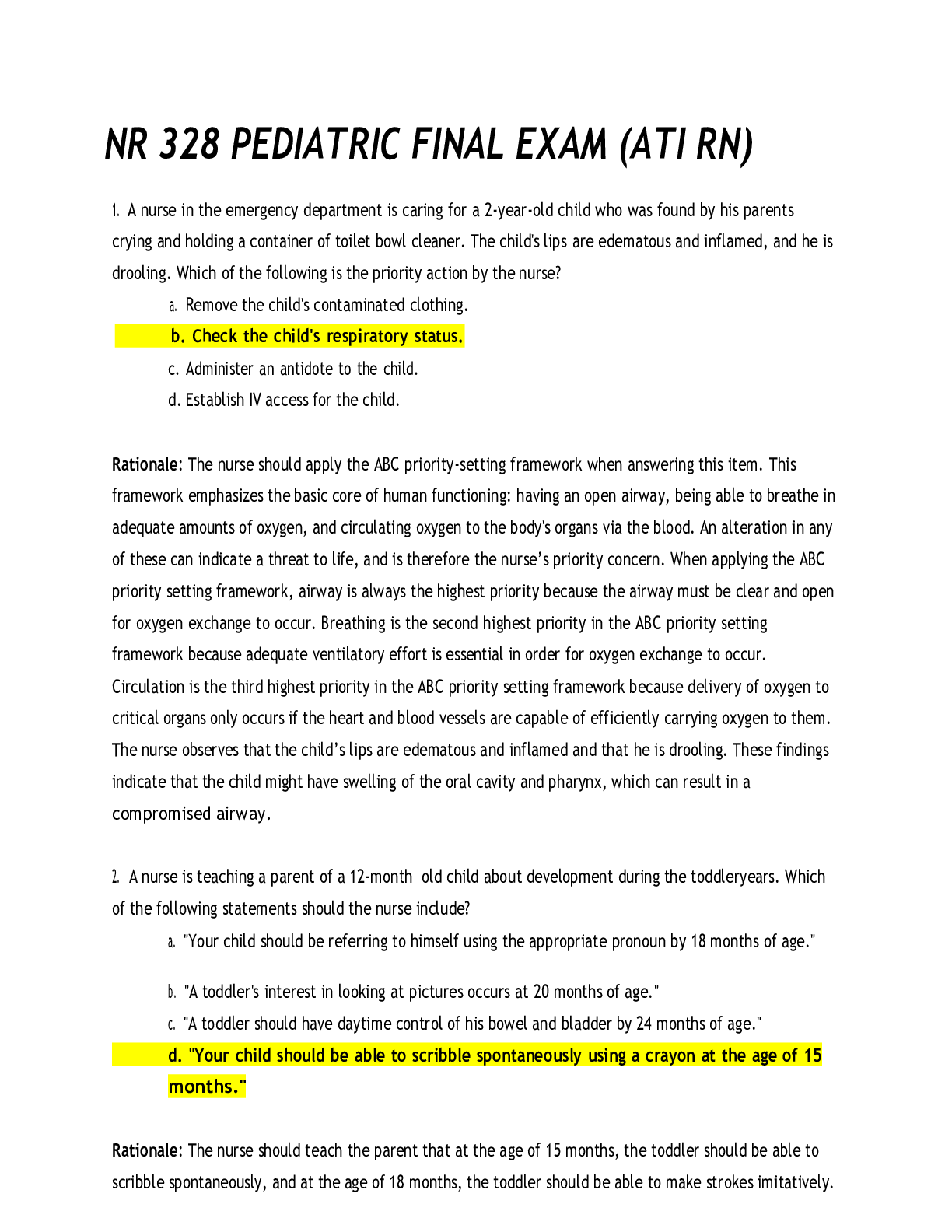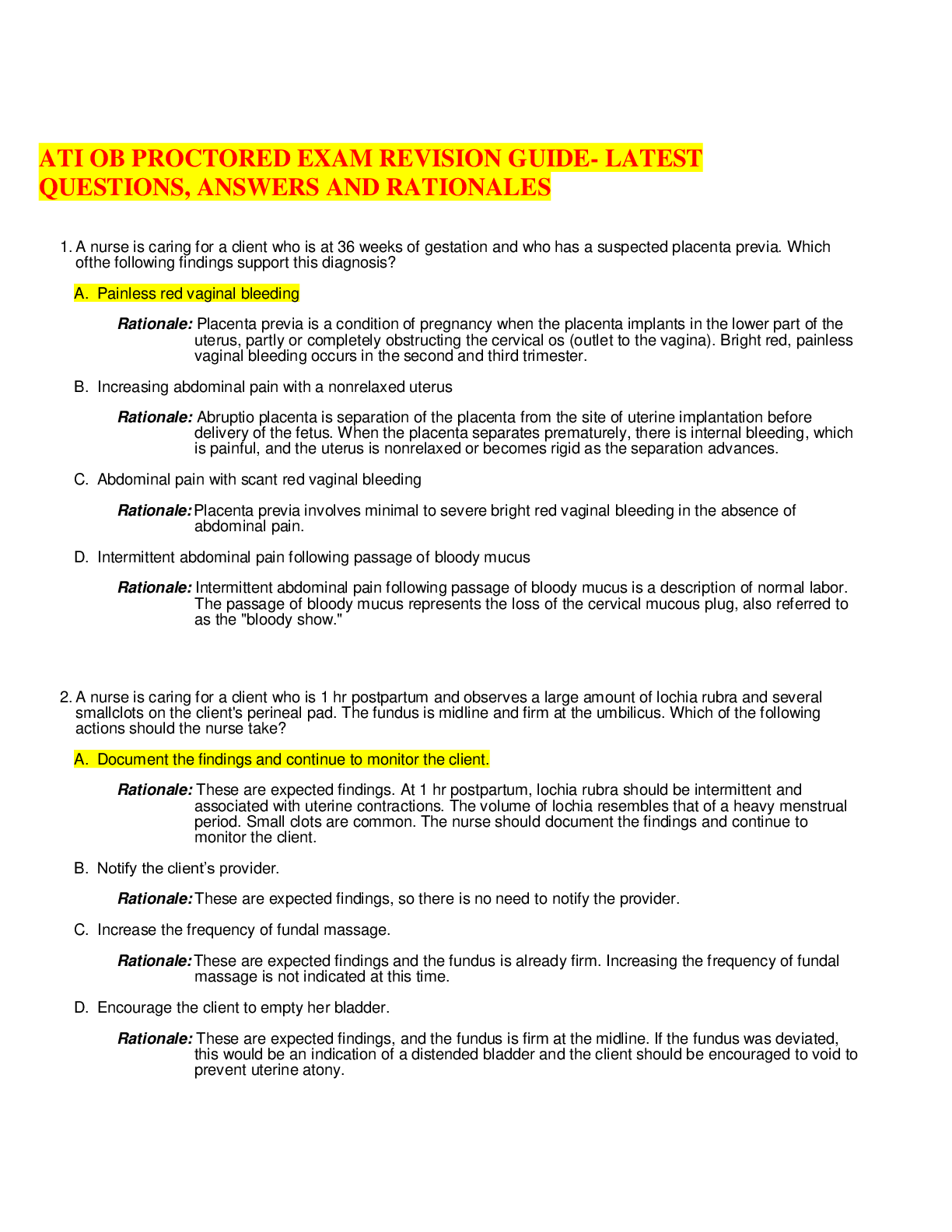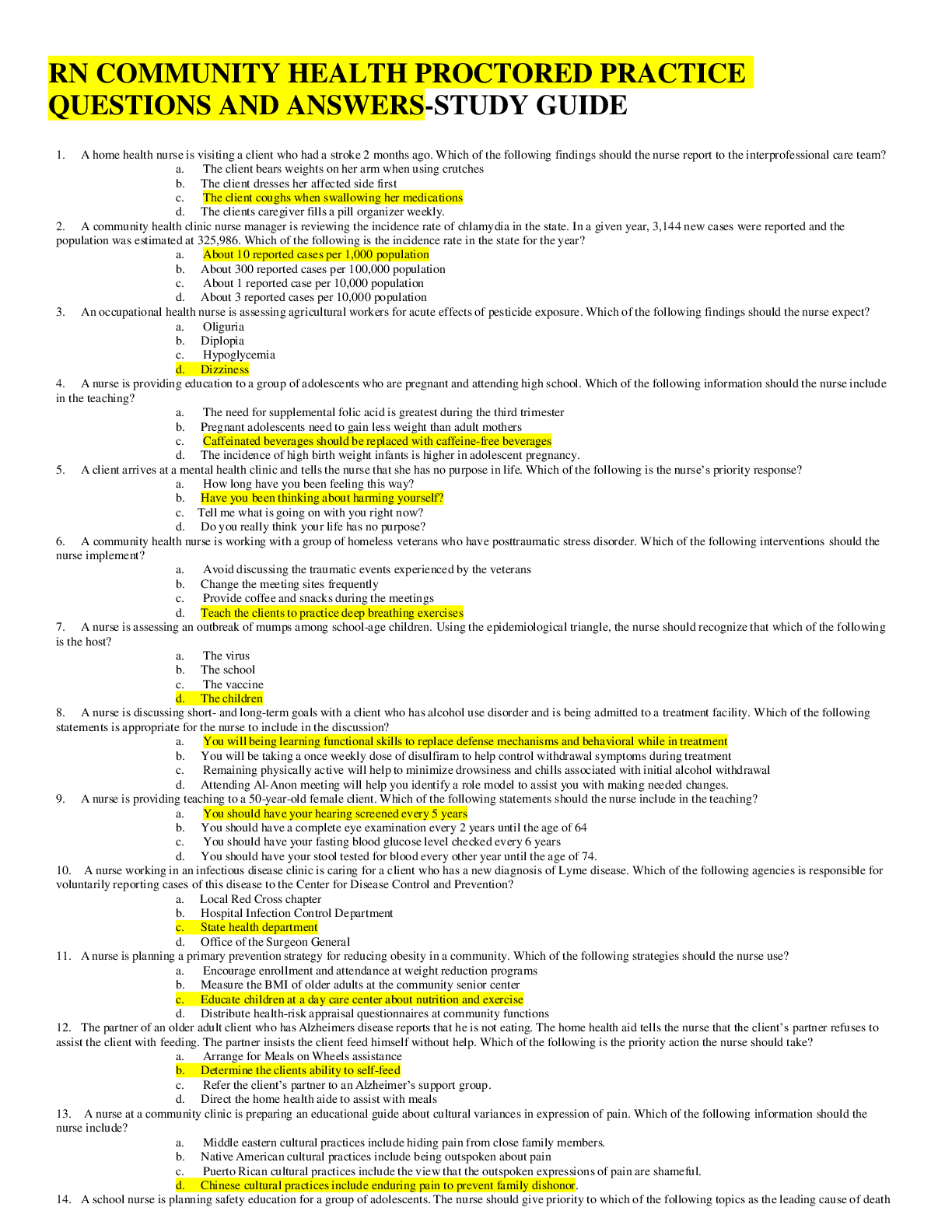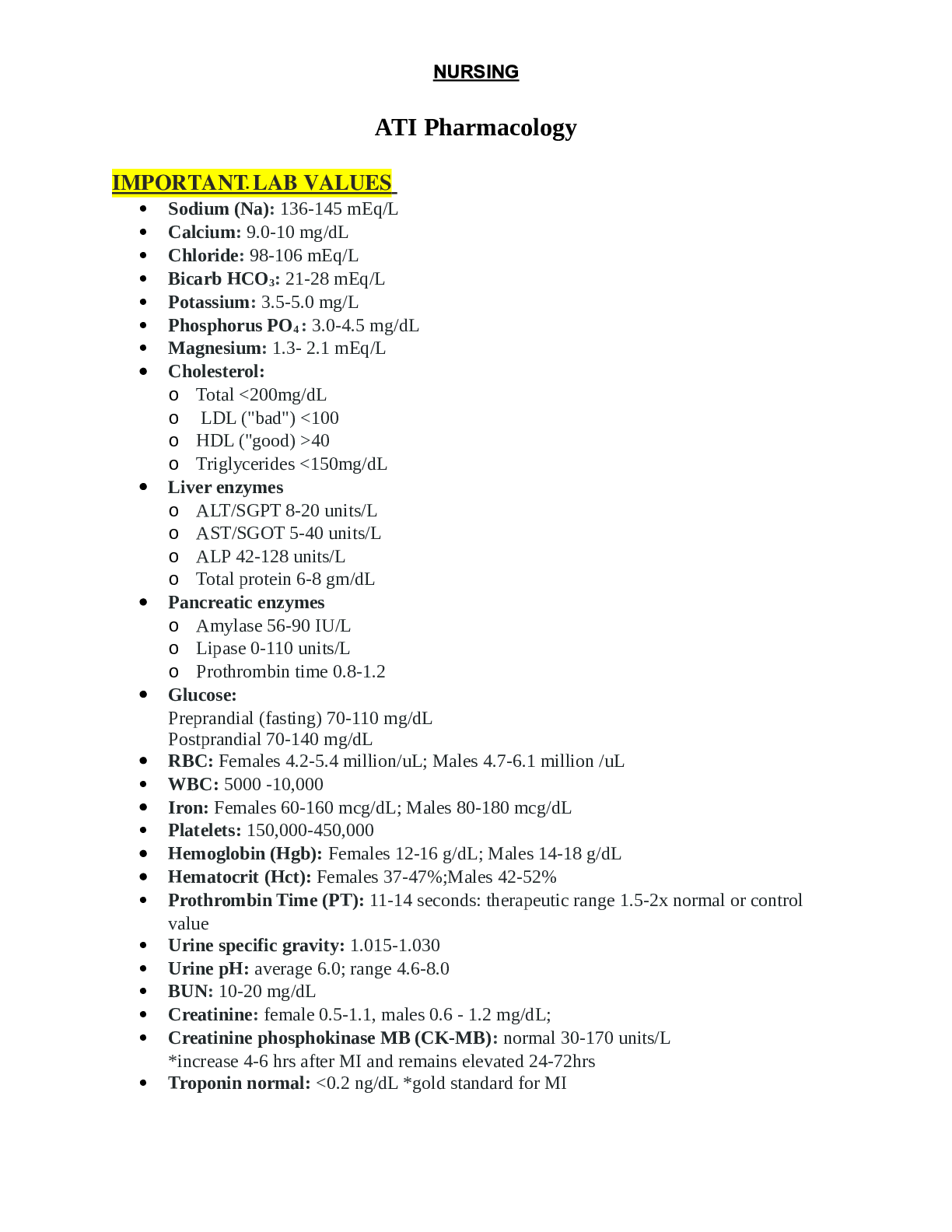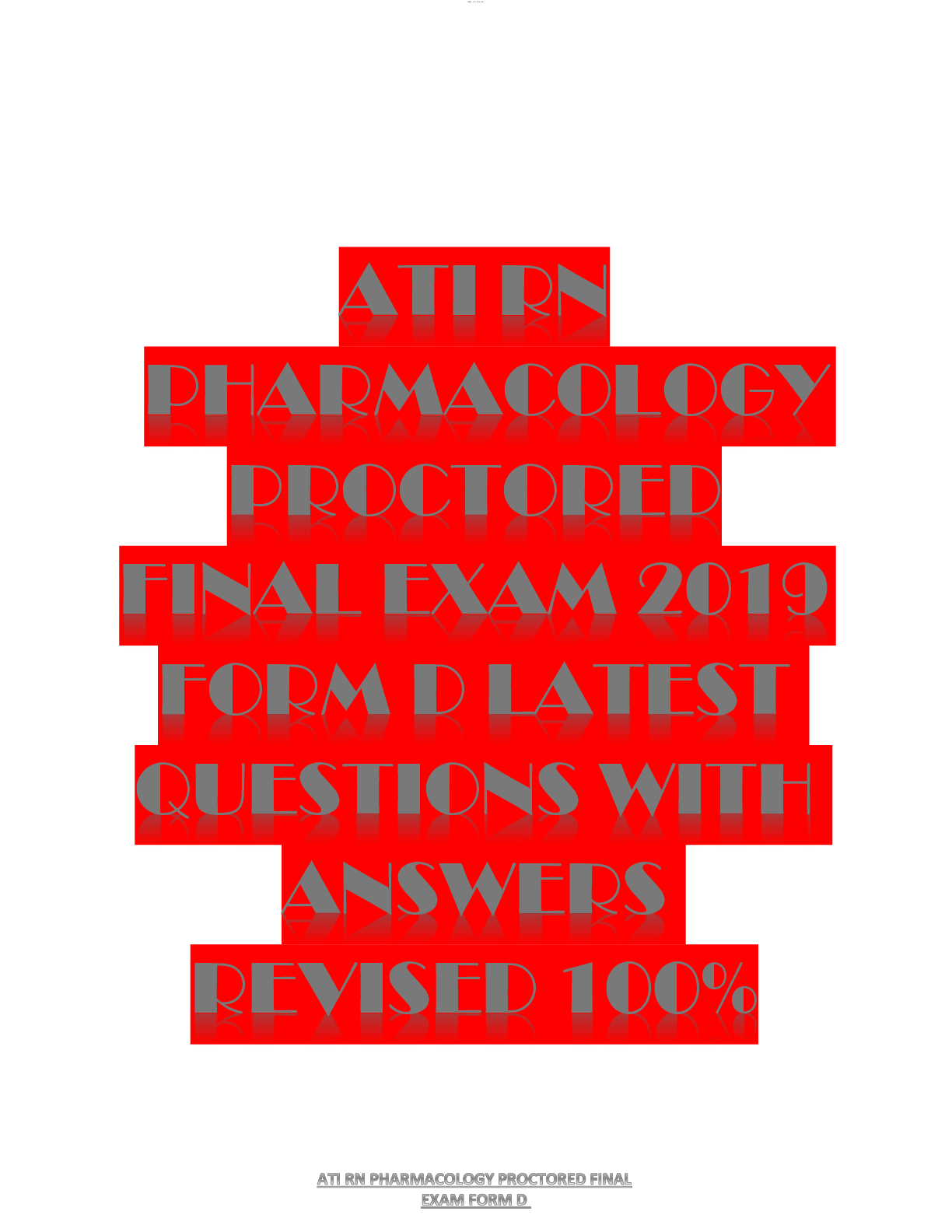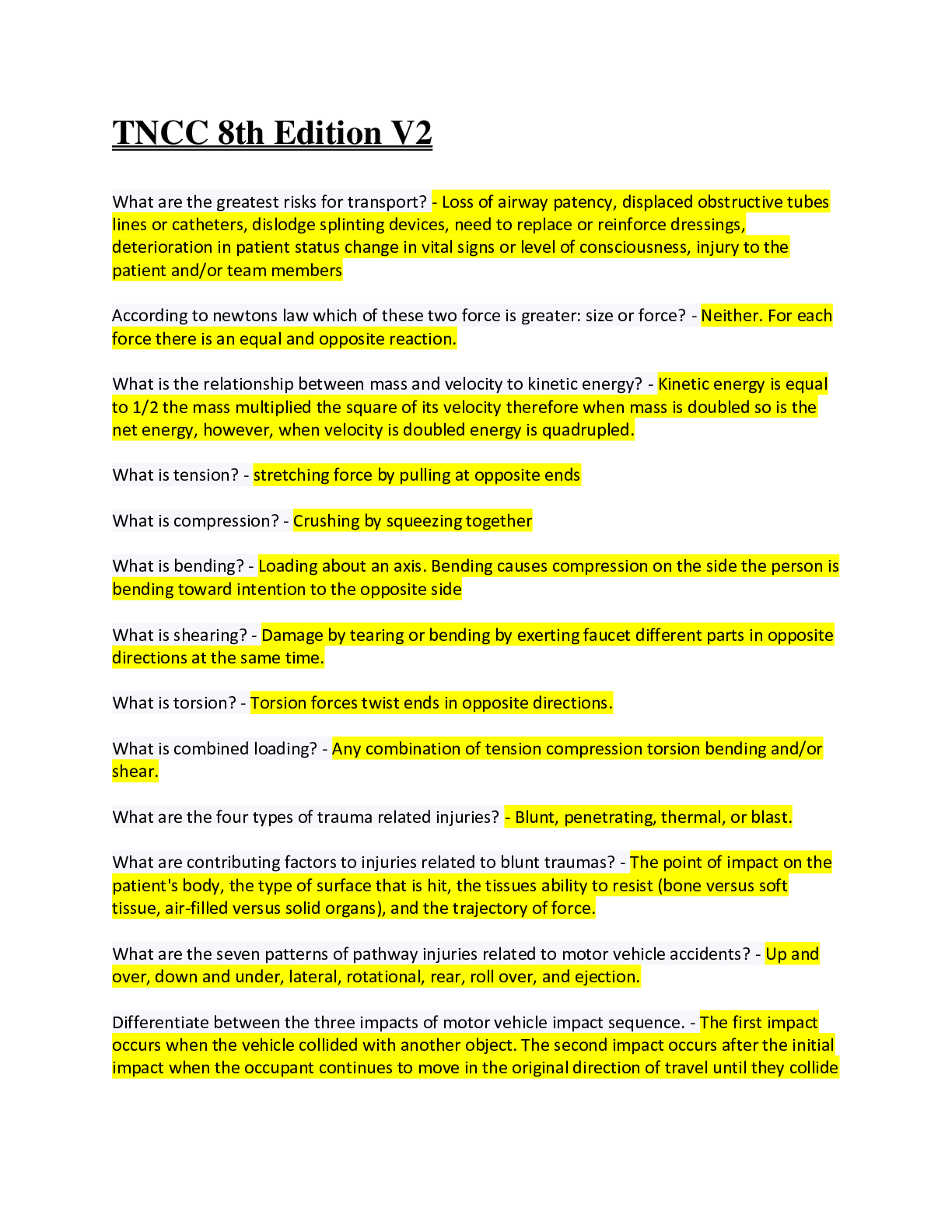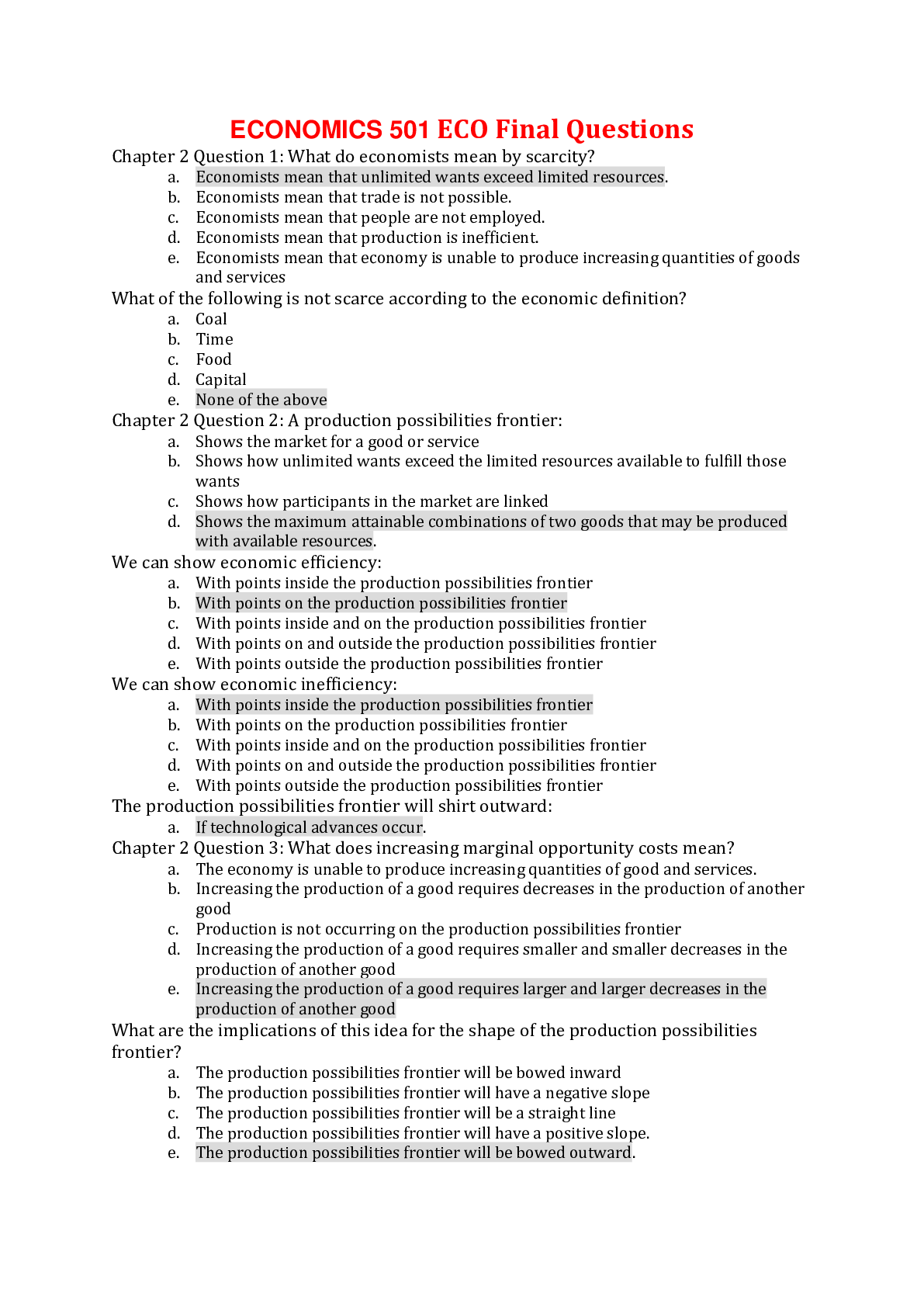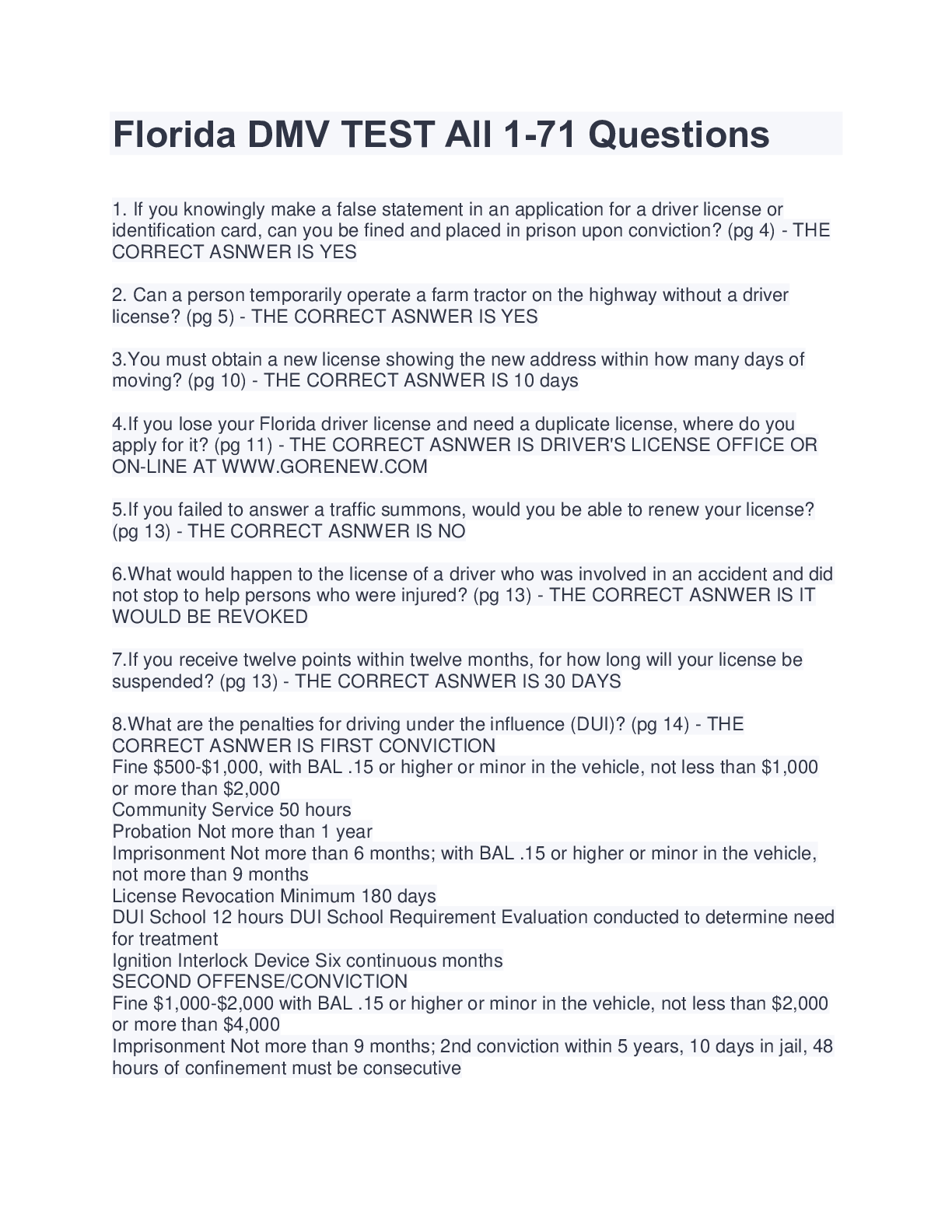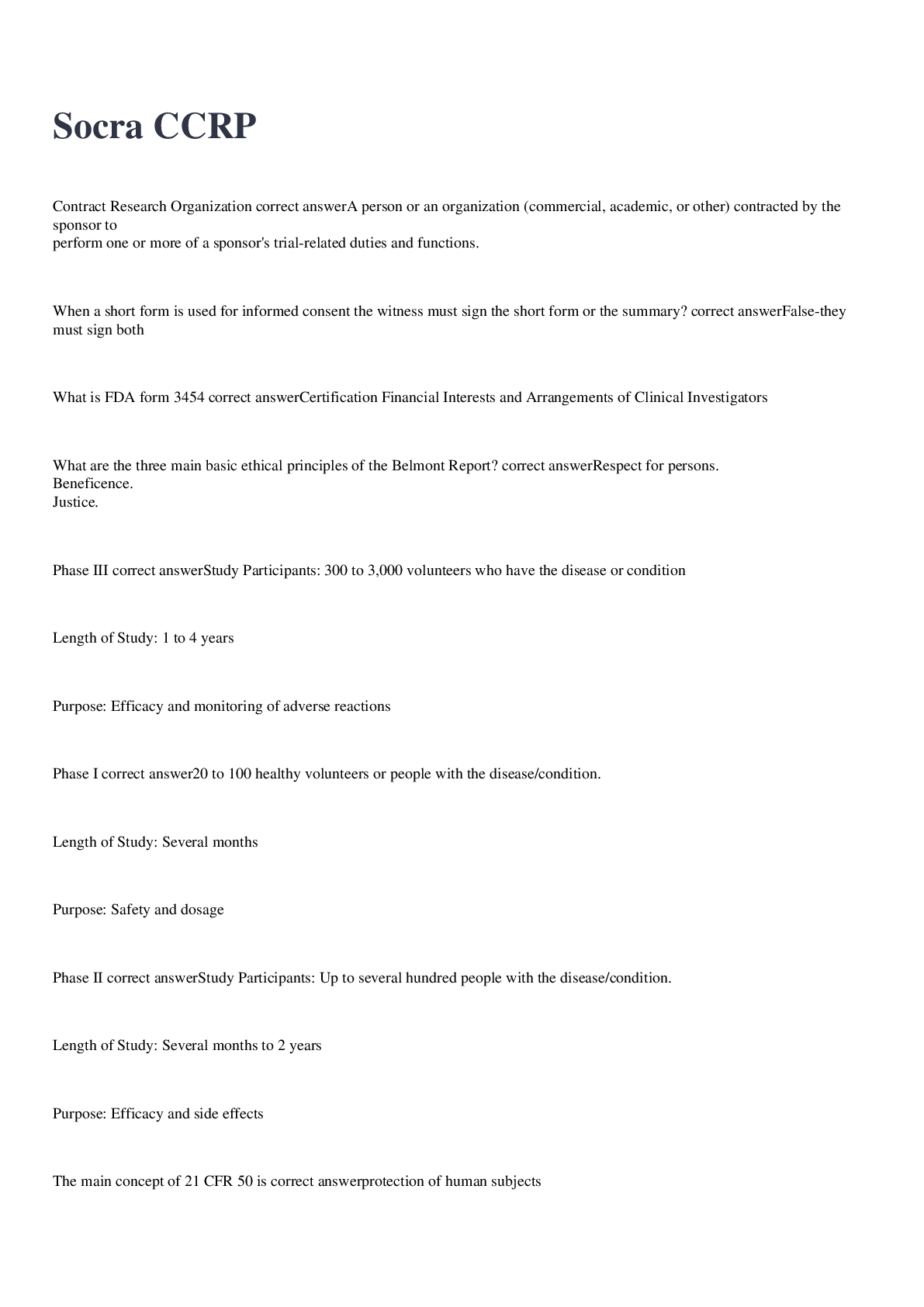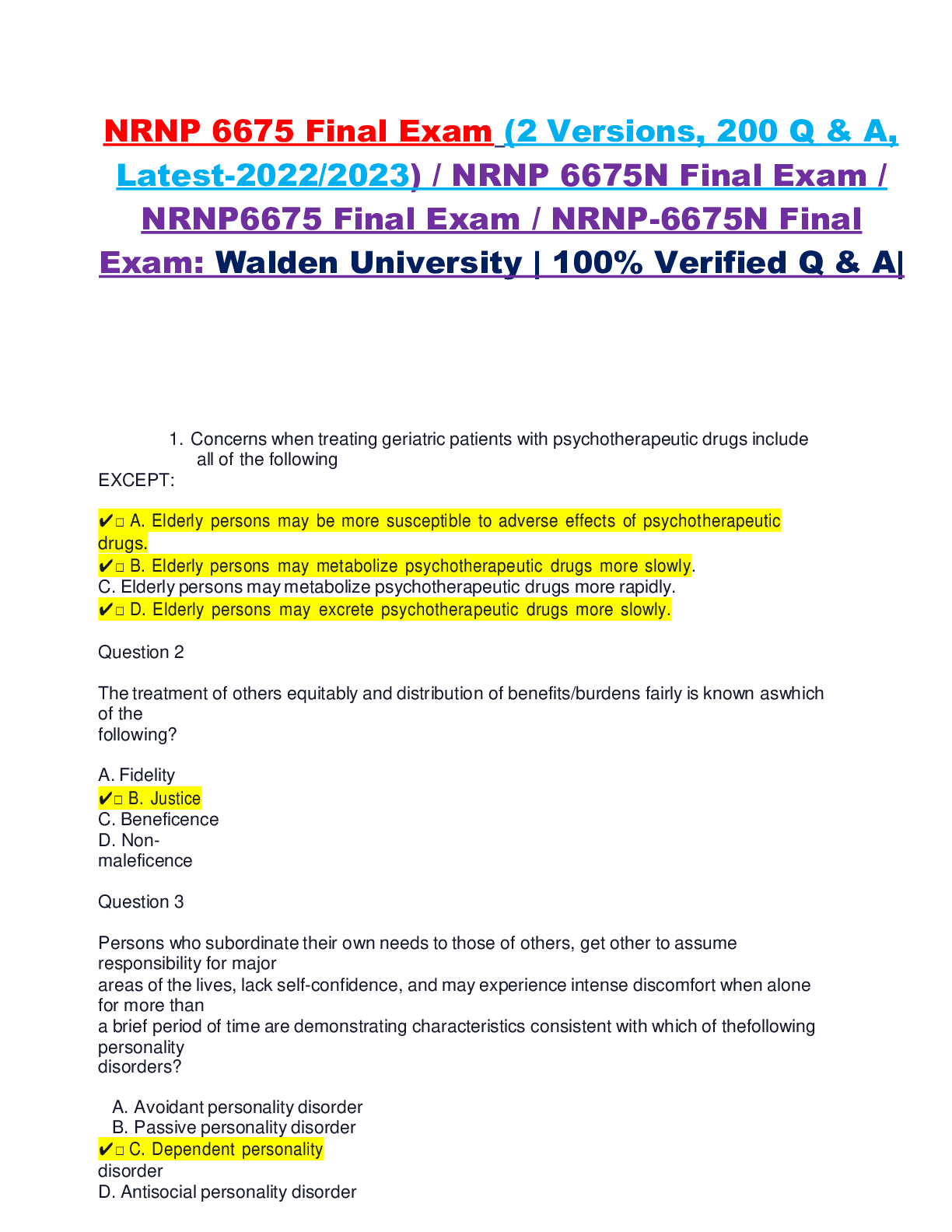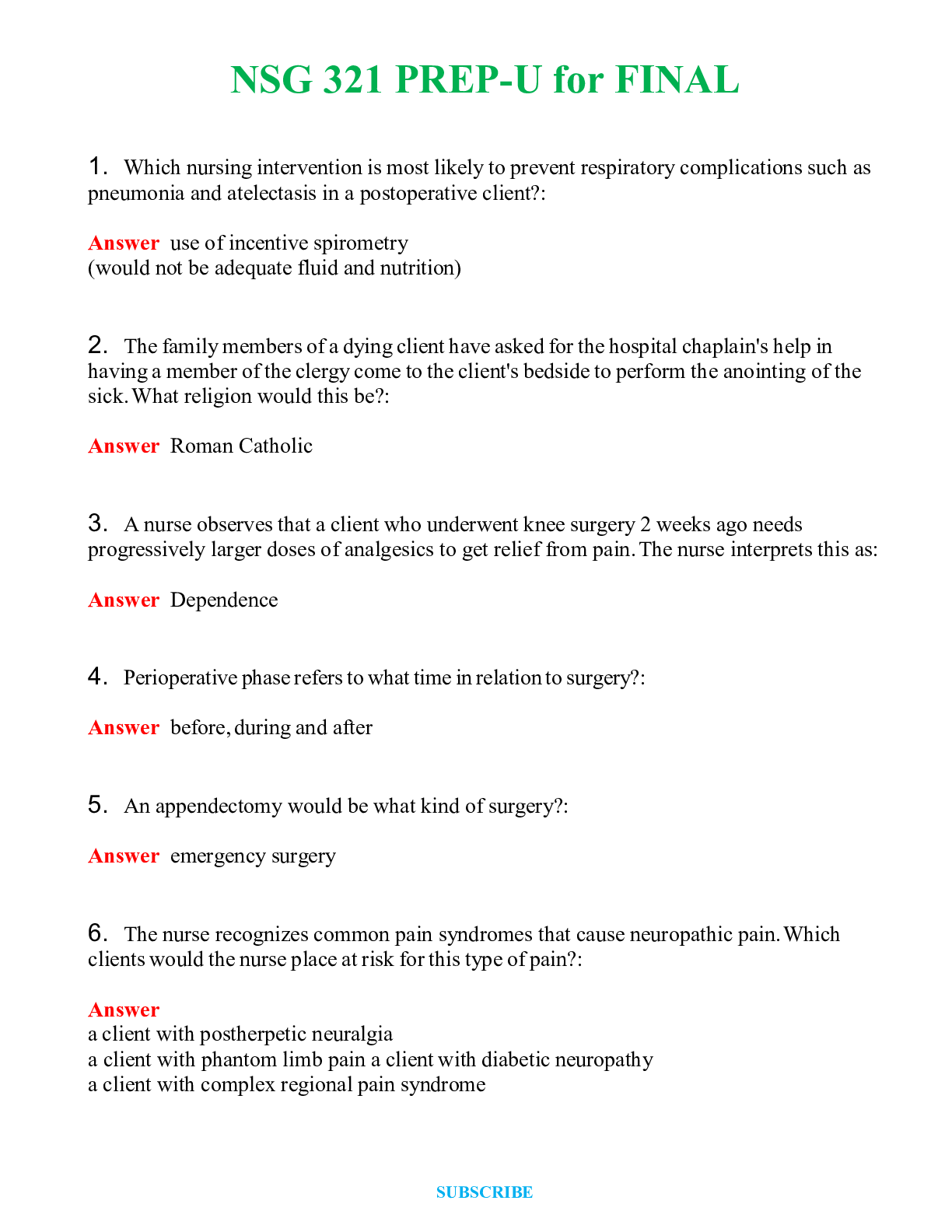ATI RN PHARMACOLOGY PROCTORED EXAM 2021
Document Content and Description Below
1. A nurse is assessing a client who is receiving intravenous therapy. The nurse should identify which of the following findings as a manifestation of fluid volume excess? a. Decreased bowel sounds ... b. Distended neck veins c. Bilateral muscle weakness d. Thread pulse 2. A nurse is caring for a client who has hyponatremia and is receiving an infusion of a prescribed hypertonic solution. Which of the following findings should indicate to the nurse that the treatment is effective? a. Absent Chvostek’s sign b. Improved cognition c. Decreased vomiting d. Cardiac arrhythmias absent 3. A nurse is teaching a client who has a new prescription for a nitroglycerin transdermal patch. Which of the following instructions should the nurse include? a. “Discontinue the patch if you experience a headache.” b. “Apply a new patch if you have chest pain.” c. “Cover the patch with dry gauze when taking a shower.” d. “Remove the patch prior to going to bed.” 4. A nurse is reviewing he laboratory results of a client who has a prescription for sodium polystyrene sulfonate (Kayexalate) every 6 hr. which of the following should the nurse report to the provider? a. Creatinine 0.72 mg/dL b. Sodium 138 mEq/L c. Magnesium 2 mEq/L d. Potassium 5.2 mEq/L - Hyperkalemia (serum potassium level greater than 5.0 mEq/L) increases the client risk for fatal cardiac dysrhythmias. Kayexalate is used to decrease the serum potassium level, so the PN should monitor the client's serum potassium level 5. A nurse is caring for a client who has tuberculosis and is taking isoniazid and rifampin. Which of the following outcomes indicates that the client is adhering to the medication regimen? a. The client has a negative sputum culture b. The client tests negative for HIV c. The client has a positive purified protein derivative test d. The client’s liver function test results are within the expected reference range 6. A client is caring for a client who develops an anaphylactic reaction to IV administration. After assessing the client’s respiratory status and stopping the medication infusion. Which of the following actions should the nurse take next? a. Replace the infusion with 0.9% sodium chloride b. Give diphenhydramine IM c. Elevate the client’s legs and feet d. Administer epinephrine IM 7. A nurse is caring for a client who is taking sertraline and reports a desire to begin taking supplements. Which of the following supplements should the nurse advise the client to avoid? a. St. John’s Wort b. Ginger root c. Black cohosh d. Coenzyme Q10 8. A nurse is caring for a client who has heart failure and a new prescription for lisinopril. For which of the following adverse effects should the nurse monitor when administering lisinopril? a. Bradycardia b. Hypokalemia c. Tinnitus d. Hypotension 9. *A nurse is assessing a client who is receiving heparin IV continuous IV. The client has an PPT of 90 seconds. They should monitor the client for which of the following changes in their vital signs? a. Decreased temperature b. Increased pulse rate c. Decreased respiratory rate d. Increased blood pressure 10. A nurse is preparing to administer medication to a client and discovers a medication error. The nurse should recognize that which of the following staff members is responsible for completing an incident report? a. The quality improvement committee b. The nurse who identifies the error c. The nurse who caused the error d. The charge nurse 11. A nurse is planning care for a client who is receiving morphine via continuous epidural infusion. The nurse should monitor the client for which of the following? a. Pruritus – Sign of allergic reaction to morphine b. Cough c. Tachypnea d. Gastric bleeding 12. A nurse is preparing to administer digoxin orally to a client. Identify the sequence of steps the nurse should take. (Move the steps into the box on the right, placing them in the order of performance. Use all the steps.) a. Obtain the client’s apical heart rate b. Remove the medication from the dispensing system c. Open the medication package d. Compare the client’s wristband to the medication administration record e. Document administration of the medication 13. A nurse is reviewing the medical record of an adult client who has a fever and a prescription for acetaminophen. Which of the following findings should the nurse identify as a contraindication for receiving this medication? a. Alcohol use disorder b. Chronic kidney disease c. Hepatitis B vaccine within the last week d. Diabetes mellitus 14. A home health nurse is visiting a client who has heart failure and a prescription for furosemide. The nurse identifies that the client has gained 2.5 kg (5 lb.) since the last visit 2 days ago. Which of the following actions should the nurse take first? a. Encourage the client to dangle the legs while sitting in a chair b. Teach the client about foods low in sodium c. Determine medication adherence by the client d. Notify the provider of the client’s weight gain 15. A nurse is preparing to administer the initial dose of penicillin G IM to a client. The nurse should monitor for which of the following as an indication of an allergic reaction following the injection? a. Urticaria b. Bradycardia c. Pallor d. Dyspepsia 16. A nurse is teaching a client who has angina a new prescription for sublingual nitroglycerin tablets. Which of the following instructions should the nurse include in the teaching? a. “Discard any tablets you do not use every 6 months.” b. “Take one tablet each morning 30 minutes prior to eating.” c. “Keep the tablets at room temperature in their original glass bottle.” d. “Place the tablet between your cheek and gum to dissolve.” 17. A nurse is providing teaching to a client who has a new prescription for theophylline, a sustained-released capsule. Which of the following statements by the client indicates an understanding of the teaching? a. “I can take my medication in the morning with my coffee.” b. “I may sprinkle the medication in applesauce.” c. “I should limit my fluid intake while on this medication.” d. “I will need to have blood levels drawn.” 18. A nurse is mixing regular insulin and NPH insulin in the same syringe prior to administering it to client who has diabetes mellitus following actions should the nurse take first? a. Withdraw the regular insulin from the viral b. Withdraw the NPH insulin form the vial c. Inject air into the NPH vial d. Inject air into the regular insulin vial 19. A nurse is preparing to administer subcutaneous heparin to a client. Which of the following should the nurse take? a. Massage the site after administering the medication b. Use a 21-gauge needle for the injection c. Aspirate before injecting the medication d. Insert the needle at least 5 cm (2 in) from the umbilicus 20. A nurse is caring for a client who has a prescription for amoxicillin. Which of the following findings indicates the client is experiencing an allergic reaction? a. Nausea b. Cardiac dysrhythmia c. Laryngeal edema d. Insomnia i. amoxicillin side effects include, renal impairment, hyperkalemia, dysrhythmias, hypernatremia ▪ allergic reaction: Urticaria, rash, hypotension, dyspnea, swelling of face/lips/tongue 21. A nurse is teaching a newly licensed nurse about medication reconciliation. The nurse should instruct the newly licensed nurse to perform medication reconciliation for which of the following? a. A client who has a referral for social services b. A client who is transdermal to radiology c. A client who is transferal to a step-down unit d. A client who has a consultation for physical therapy 22. A nurse is reviewing the laboratory values of a client who is taking atorvastatin. Which of the following laboratory values indicates the treatment has been effective? a. BUN 15 mg/dL b. Blood glucose 90 mg/dL c. Urine specific gravity 1.020 d. LDL 120 mg/dL 23. A nurse is receiving a medication prescription by telephone from a provider. The provider states, “Administer 6 milligrams of morphine IV push every 3 hours as needed for acute pain.” How should the nurse transcribe the prescription in the client’s medical record? a. Morphine 6 mg IV push every 3 hr PRN acute pain b. MSO 6 mg IV push every 3 hr PRN acute pain c. MS 6 mg IV push every 3 hr PRN acute pain d. Morphine 6.0 mg IV push every 3 hr PRN acute pain 24. A nurse is assessing a client’s IV infusion site and notes that the site is cool and edematous. Which of the following actions should the nurse take? a. Show the IV solution rate b. Initiate a new IV distal to the initial site c. Maintain the extremity below the level of the heart d. Apply a warm, moist compress 25. A nurse is providing teaching to a client who has a new prescription for clozapine. Which of the following statements should the nurse include in the teaching? a. “Diarrhea is a common adverse effect of this medication.” b. “Ringing in the ears is an expected adverse effect of this medication.” c. “Notify your provider if you develop a fever while taking this medication.” d. “You might experience weight loss while taking this medication.” 26. A nurse is teaching a client about oral contraceptive. Which of the following information should the nurse include in the teaching? a. Abdominal pain is an expected adverse effect of oral contraceptives b. It can take up to 1 year to become pregnant after stopping an oral contraceptive c. Some herbal supplements can decrease the effectiveness of an oral contraceptive d. A pelvic examination is needed prior to starting an oral contraceptive 27. A nurse is planning to administer medication to an older adult client who has dysphagia. Which of the following actions should the nurse plan to take? a. Tilt the client’s head back when administering the medications b. Mix the medications with a semisolid food for the client c. Administer more than one pill to the client at a time d. Place the medications on the back of the client’s tongue 28. A nurse is providing teaching to a client about the administration of omeprazole. Which of the following should the nurse include? a. “You cannot take this medication with an antacid.” b. “You should reduce your intake of calcium while taking this medication.” c. “You should take this medication before meals.” d. “You can take a second dose if symptoms persist up to 2 hours after the first dose.” 29. A nurse is assessing for allergies with a client who is scheduled to receive the influenza vaccine. Which of the following allergies should the nurse report to the provider as a possible contraindication to receiving the vaccine? a. Eggs b. Shellfish c. Peanuts d. Milk 30. A nurse is caring for a client who has a new diagnosis of benign prostate hypertrophy and a prescription for doxazosin. The client tells the nurse. “I do not take this medication. I would prefer a natural therapy.” Which of the following supplements should the nurse suggest the client discuss with the provider? a. Black cohosh b. Garlic c. Feverfew d. Saw palmetto 31. A nurse is caring for a client who is taking digoxin to treat heart failure. Which of the following predisposes this client to developing digoxin toxicity? a. Taking a high ceiling diuretic b. Having a 10-year history of COPD c. Having a prolapsed mitral valve d. Taking an HMG CoA reductase inhibitor 32. A nurse is administering naloxone to a client who has developed an adverse reaction to morphine. The nurse should identify which of the following findings as a therapeutic effect of naloxone? a. Decreased nausea b. Increased pain relief c. Decreased blood pressure d. Increased respiratory rate 33. A nurse is reviewing the medical record of a client who has sinusitis and a new prescription for cefuroxime. Which of the following client information is the priority for the nurse to report to the provider? a. The client has a BUN of 18 mg/dL b. The client takes an aspirin daily c. The client has a history of a severe penicillin allergy d. The client reports a history of nausea with cefuroxime 34. A nurse is assessing a client who has hypermagnesemia. Which of the following medications should the nurse prepare to administer? a. Protamine sulfate b. Acetylcysteine c. Calcium gluconate d. Flumazenil 35. A nurse is assessing a client following the administration of ondansetron (Zofran). Which of the following findings should indicate to the nurse that the ondansetron has been effective? a. Client reports a decrease in pain b. Client reports a decrease in nausea c. Client reports a decrease in coughing d. Client reports a decrease in diarrhea 36. A nurse manager is planning an in-service about pain management with opioids for client who has cancer. Which of the following information should the nurse manager include? a. IM administration is recommended if PO opioids are ineffective b. Respiratory depression decreases as opioid tolerance develops c. Meperidine is the opioid of choice for treating chronic pain d. Withhold PRN pain medication for the client who is receiving opioids every 6 hr 37. A nurse is reviewing the list of current medication for a client who is to start prescription for carbamazepine. The nurse should identify that which of the following medications interacts with carbamazepine? a. Nicotine transdermal system b. Diphenhydramine c. Estrogen-progestin combination (Non-hormonal forms of contraception) d. Beclomethasone 38. A nurse is caring for a client who has a respiratory infection and is receiving an antibiotic. Which of the following medications puts the client at risk for developing hearing loss? a. Rifampin b. Ciprofloxacin c. Penicillin G d. Gentamicin 39. A nurse is teaching a guardian of a school-age child who has a new prescription for a fluticasone metered-dose inhaler. Which of the following information should the nurse include in the teaching? (SATA) a. “Soak the inhaler in water after use.” b. “Have your child take one inhalation as needed for shortness of breath.” c. “Shake the device prior to administration.” d. “A spacer will make it easier to use the device.” e. “Rinse your child’s mouth following administration.” 40. A nurse is preparing to administer potassium chloride elixir 20 mEq/day PO to divide equally 12 hr. available is 6.7 mEq/5 mL. How many mL should the nurse administer per dose? (Round the answer to the nearest tenth. Use a leading zero if it applies. Do not use a trialing zero.) a. 7.5 mL 41. A nurse is instructing a client who has a new prescription for a daily dose of lovastatin extended release. Which of the following information should the nurse include in the teaching? a. “You will need liver function tests before beginning therapy.” b. “Avoid consuming dairy products while taking this medication.” c. “You may crush the medication and mix it with applesauce.” d. “You should take the medication in the morning.” 42. A nurse is assessing a client who is receiving a peripheral IV infusion and notes infiltration of fluid into the tissue surrounding the insertion site. Which of the following actions should the nurse take? a. Flush the IV catheter b. Apply pressure to the IV site c. Elevate the extremity d. Slow the infusion rate 43. A nurse is preparing to administer 4,000 units of heparin subcutaneously to a client who has deep-vein thrombosis. Available is heparin 10,000 units. How many mL of heparin should the nurse administer? (Round to the nearest tenth. Use a leading zero if it applies. Do not use a trailing zero.) a. 0.4 mL 44. *A nurse us caring for a client who is in shock and is receiving an infusion of albumin. Which of the following findings should the nurse expect? a. Oxygen saturation 96% b. PaCO2 30 mm Hg c. Increase in BP d. Decrease in protein 45. A nurse is discussing adverse reactions to pain medications in older adult clients with a newly licensed nurse. Which of the following findings should the nurse include as risk factors for an adverse drug reaction? (SATA) a. Polypharmacy b. Increased rate of absorption c. Decreased percentage of body fat d. Multiple health problems e. Decreased renal function 46. A nurse is reviewing the laboratory data of a client prior to administering IV tobramycin. Which of the following laboratory values should the nurse report to the provider? a. Sodium 137 mEq/L b. Hct 4.3% c. Hgb 15 g/dL d. Creatinine 2.5 mg/dL 47. A nurse is preparing to administer enoxaparin to a client. Which of the following actions should the nurse take? a. Apply firm pressure to the injection site following administration b. Administer the medication into the client’s muscle c. Expel the air bubble from the syringe prior to injection d. Insert the syringe needle halfway into the client’s skin 48. A nurse is reviewing a client’s 0800 laboratory values at 1100. The nurse notes that the client received heparin at 1000. Which of the following laboratory values warrants an incident report? a. ePTT 90 seconds b. Hgb 16 g/dL c. INR 1.6 d. WBC 6,000/mm3 49. A nurse is caring for a client who has breast cancer and reports pain. 1 hr after administration of prescribed morphine 10 mg IV. Which of the following medications should the nurse expect to administer? a. Naloxone IV b. Morphine tablet c. Lidocaine patch d. Fentanyl transmucosal 50. A nurse is assessing a client who reports taking over-the-counter antacids. Which of the following findings should the nurse identify as a manifestation of hypercalcemia? a. Constipation b. Decreased urine output c. Positive Trousseau’s sign d. Headache CONTINUED ...DOWNLOAD FOR BEST SCORES [Show More]
Last updated: 1 year ago
Preview 1 out of 20 pages

Reviews( 0 )
Document information
Connected school, study & course
About the document
Uploaded On
Oct 22, 2021
Number of pages
20
Written in
Additional information
This document has been written for:
Uploaded
Oct 22, 2021
Downloads
0
Views
230

